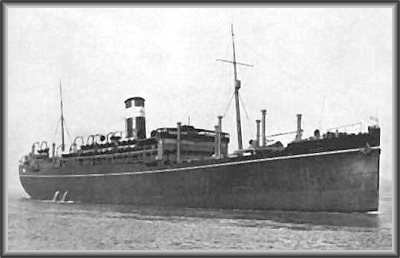By: Phil Kohn. Dedicated to the memory of his father, GM3 Walter Kohn, U.S. Navy Armed Guard, USNR, and all men and women who have answered the country’s call in time of need. Phil can be contacted at ww2remembered@yahoo.com.
HMT Rohna, a British troop transport, on November 26, 1943, is attacked in the eastern Mediterranean by a Luftwaffe plane using a radio-guided bomb. The ship sinks, killing 1,015 American GIs and 135 British and Australian servicemen. It is the largest loss of U.S. soldiers to enemy action at sea in the war. The disaster is kept secret, as the Allies do not wish to disclose that the Germans possess such an intimidating weapon. Consequently, the destruction of HMT Rohna will remain virtually unknown to the public until many years after the war.
The British Eighth Army on November 27 brings an armored brigade into the bridgehead it has made on the north bank of the Sangro River in eastern central Italy. The tanks will support the Allied forces fighting there. At the Cairo Conference, President Roosevelt, Prime Minister Churchill and Chinese president Chiang Kai-shek release the Cairo Declaration, which says among other things that “all the territories that Japan has stolen from the Chinese . . . shall be restored to the Republic of China.” They also state that “in due course, Korea [a territory of Japan since 1910] shall become free and independent.”
The Tehran Conference convenes on November 28 in Iran. U.S. President Franklin Roosevelt, British Prime Minister Winston Churchill and Soviet leader Joseph Stalin meet for the first time to discuss war strategy. In the Pacific, a battalion-sized force of U.S. Marines lands at Koiari, on Bougainville Island, to harass Japanese troops stationed there.
In Italy, the British Eighth Army continues to make progress along the Sangro River. Mozzagrogna is captured on November 29, as is Fossacesia, at the mouth of the river near the Adriatic Sea, later in the day. In the Bismarck Archipelago, four U.S. destroyers bombard Japanese positions on the south shore of New Britain island. On Papua-New Guinea, Australian troops take Gusika and Bongo. Sio, the site of a major Japanese operating base on the coast farther north, is shelled by Allied warships. The Anti-Fascist Council of National Liberation for Yugoslavia, meeting in Bosnia-Herzegovina, declares that the government-in-exile is illegitimate, the monarchy will not be restored after the war and that post-war Yugoslavia will consist of a federation of six republics headed by Josip Broz Tito.
In Tehran, Iran, Churchill, Roosevelt and Stalin hammer out an agreement on November 30 concerning “Operation Overlord,” an invasion of western Europe, planned for May 1944. Finally, Stalin has gained what he has long sought: the opening of a second European front.
The U.S., the U.K. and China on December 1, 1943, issue a joint statement from the Cairo Conference, which ended five days earlier: They pledge to defeat Japan and strip Nippon of all territory gained since 1895. On the same day, the Tehran Conference concludes with the U.S., the U.K. and the U.S.S.R. in substantial agreement on the division of post-war Germany and the westward movement of Poland’s western and eastern frontiers (without any input from the Poles). In Ukraine, Soviet forces isolate the Germans in the Crimea. The neutral Swedish ocean liner MS Gripsholm docks in New York Harbor, repatriating 1,223 Americans, 217 Canadians and a small number of Latin Americans brought from Mormugao, Portuguese India. They were trapped in Japan at the start of the war and were exchanged for Japanese civilians similarly caught in the U.S. at the outbreak of hostilities.
Bari, Italy, becomes the only European city to be exposed to chemical-warfare agents during the war — unintentionally. A Luftwaffe raid by 105 Junkers JU 88 bombers on December 2 hits the harbor at Bari, crowded with Allied ships. Over 1,000 people are killed in the attack and 38,000 tons of supplies are destroyed. Eighteen vessels are sunk, including the American Liberty ship SS John Harvey, which is carrying a highly secret cargo of 2,000 mustard-gas bombs (being brought to the front to retaliate in case the Germans initiate chemical warfare). In the explosion that destroys Harvey, liquid sulfur mustard is released into the harbor waters and a cloud of sulfur mustard gas blows over the city. Because the Americans never notified anyone of the presence of the sulfur mustard, doctors are unaware that many of the wounded, rescuers and sick civilians they are treating are victims of mustard gas rather than immersion, exposure or wounds (only). Deaths resulting from mustard exposure alone are hard to determine, but estimates indicate around 83 military (including merchant seamen) and over 1,000 Italian civilians died. (Per orders of both Roosevelt and Churchill, all records pertaining to the incident are destroyed and the entire affair kept secret for years [until 1959 in the U.S.].) British troops capture Lanciano, Italy, on the Adriatic, 100 miles east of Rome. In Germany, der Führer approves conscription of Hitlerjugend (Hitler Youth, the youth organization of the Nazi Party) for active military service. Members are aged 14-18.





